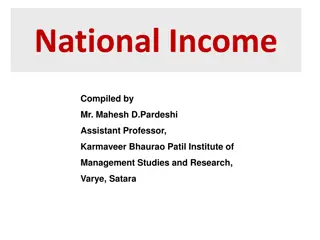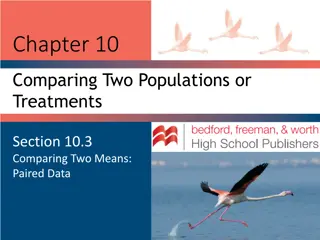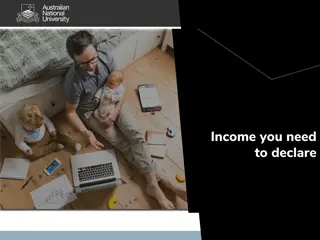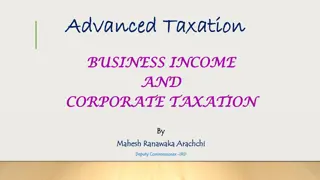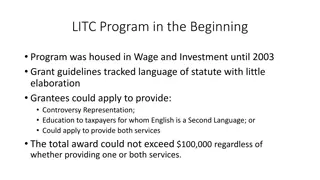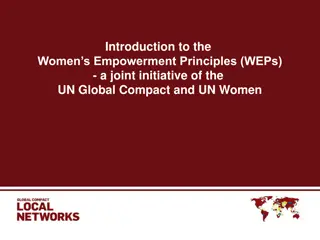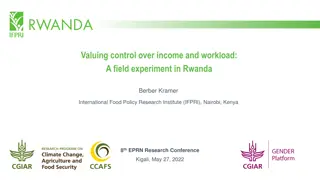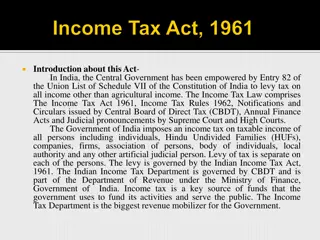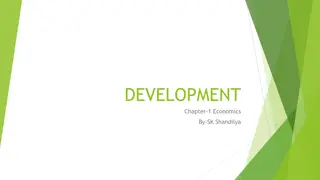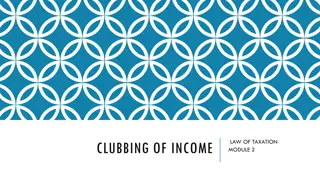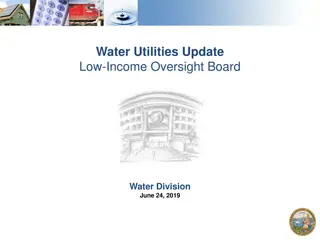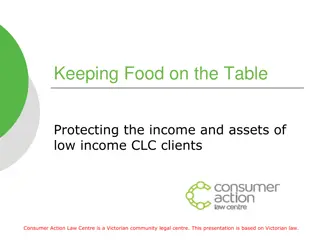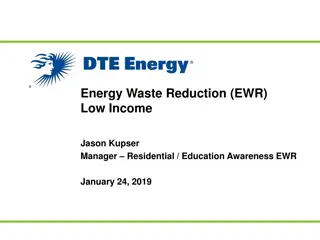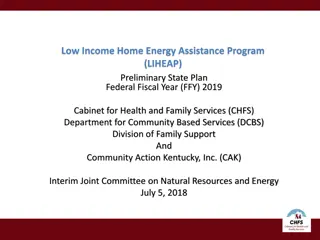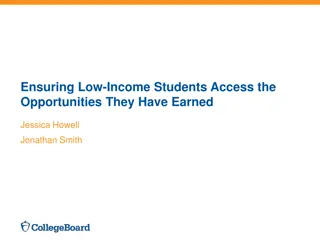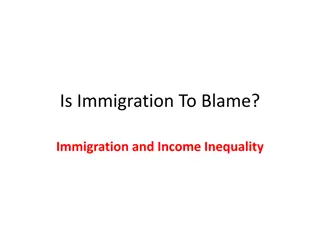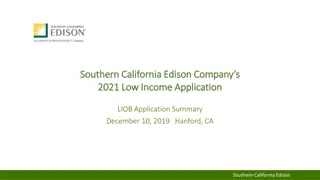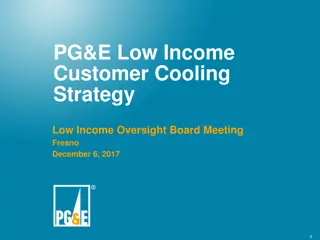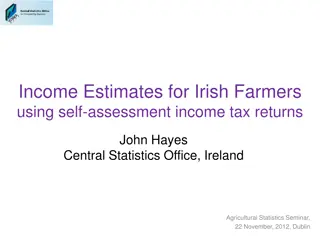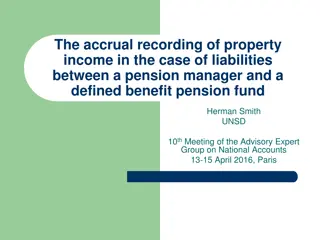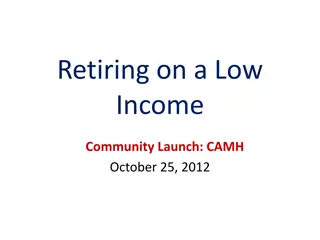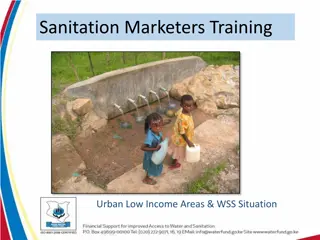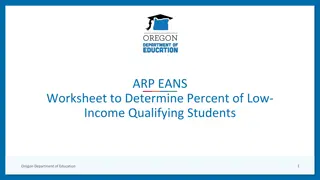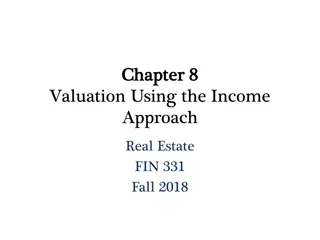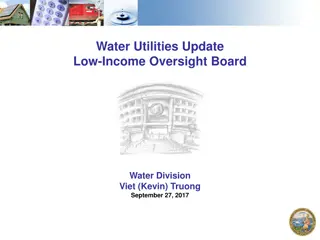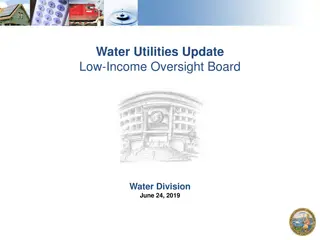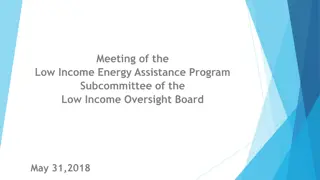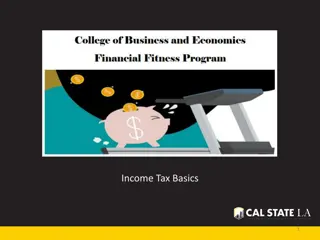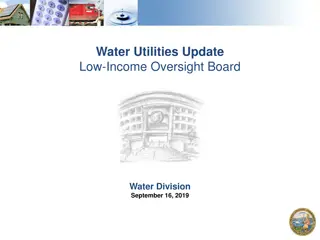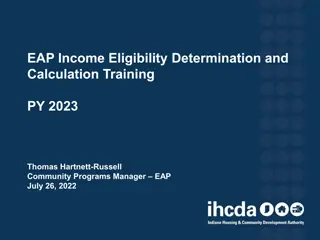Understanding Concepts of National Income in Economics
Explore the concepts of national income presented by Dr. Rashmi Pandey, covering key indicators such as Gross National Product (GNP), Gross Domestic Product (GDP), Net National Product (NNP), Net Domestic Product (NDP), Personal Income, Disposable Income, Per Capita Income, and Real Income. Gain ins
0 views • 22 slides
Understanding National Income and Its Importance in Economics
National income is a crucial measure of the value of goods and services produced in an economy. It provides insights into economic growth, living standards, income distribution, and more. Concepts such as GDP, GNP, Personal Income, and Per Capita Income help in understanding the economic health of a
5 views • 14 slides
Understanding the Income Approach to Property Valuation
The income approach to property valuation involves analyzing a property's capacity to generate future income as an indication of its present value. By considering income streams from rent and potential resale, commercial property owners can convert income forecasts into value estimates through proce
8 views • 49 slides
Chapter 10.Comparing Two Populations or Treatments
In a study of identical twins raised in high-income and low-income households, researchers compared IQ scores between the siblings. The analysis revealed that twins from high-income households had a higher mean IQ of 109.5 compared to 103.667 for those raised in low-income households. Although there
9 views • 52 slides
Understanding Income Tax in India: Gross vs Total Income
In India, income tax is calculated based on the total income or taxable total income. The gross total income includes earnings from all sources like salary, property, business, and capital gains. Various additions such as clubbing provisions, adjustments for losses, unexplained credits, investments,
0 views • 7 slides
Understanding Tax Obligations and Assessable Income in Australia
In Australia, residents are taxed on worldwide income while non-residents are taxed only on Australian-sourced income. The tax liability is calculated based on taxable income, tax offsets, other liabilities like Medicare levy, and PAYG credits. Assessable income includes employment income, super pen
0 views • 13 slides
Mississippi Home Corporation - National Housing Trust Fund Program Overview
Mississippi Home Corporation (MHC) administers the National Housing Trust Fund (HTF) Program in Mississippi to address housing needs for low-and-moderate-income residents. The program aims to enhance economic viability by providing safe, decent, and affordable housing options, helping families build
2 views • 95 slides
Understanding Sri Lanka's Inland Revenue Act No. 24 of 2017
This content delves into the key aspects of the Inland Revenue Act No. 24 of 2017 in Sri Lanka, covering chargeability of income tax, imposition of income tax, definitions, sources of income, assessable income for residents and non-residents, income tax payable, and income tax base. It provides valu
0 views • 93 slides
Understanding Income from House Property in Taxation
House property income refers to rent received from properties owned by an individual, charged under income tax. It is based on the concept of annual value, representing the expected rental income or market value of the property. The annual value is taxable under the head "Income from House Property.
1 views • 12 slides
Evolution of Low Income Taxpayer Clinics (LITC) Program
The Low Income Taxpayer Clinics (LITC) Program has evolved over the years to ensure fairness and integrity in the tax system for low-income taxpayers and those who speak English as a second language. Initially housed in Wage and Investment, the program now reports to the National Taxpayer Advocate.
0 views • 10 slides
Empowering Women for Sustainable Development: The Women's Empowerment Principles
Gender equality and women's empowerment are essential for sustainable development, recognized as fundamental human rights. The Women's Empowerment Principles (WEPs) emphasize the business case for promoting women's economic participation, which leads to enhanced economic growth, social development,
1 views • 15 slides
Valuing Control Over Income and Workload in Rwanda
Field experiment in Rwanda explores trade-offs for policymakers, such as introducing new crop varieties impacting income control for women. The study assesses the value of programs affecting workload, income autonomy, and empowerment through lab-in-the-field experiments and surveys. Experimental tas
2 views • 11 slides
Overview of Income Tax Authorities in India
The Income Tax Act in India empowers the Central Government to levy taxes on all income except agricultural income. The Income Tax Department, governed by the Central Board of Direct Taxes, plays a crucial role in revenue mobilization. Understanding the functioning, powers, and limitations of tax au
0 views • 14 slides
Understanding Residuary Income and Taxable Sources
Residuary income, under section 56(1), includes all income not excluded from total income and subjected to income tax under "Income from other sources." Certain specific incomes listed in section 56(2) are taxable, such as dividends, winnings, employee contributions, interest on securities, and inco
0 views • 9 slides
Overview of Development Economics and Goals
Development economics is a branch of economics that focuses on improving the economies of developing countries by targeting factors such as health, education, working conditions, and policies. It involves macroeconomic and microeconomic analysis to enhance domestic and international growth. Differen
1 views • 11 slides
Understanding Clubbing of Income in Taxation
Clubbing of income refers to including another person's income in the taxpayer's total income to prevent tax avoidance practices like transferring assets to family members. This concept is addressed in sections 60 to 64 of the Income Tax Act. Key terms include transferor, transferee, revocable trans
1 views • 16 slides
Water Utilities Update and Low-Income Oversight Board Summary Report
This report covers various topics such as low-income assistance, school lead testing, water rate design, school lead testing legislation, water production reports, and proposed funding for safe and affordable water. It also discusses acquisitions of smaller water systems and the benefits of consolid
0 views • 9 slides
Managing Debt and Protecting Client Assets in Victoria
Consumer Action Law Centre in Victoria focuses on assisting low-income clients in managing debt and protecting their assets. The presentation emphasizes assessing the need for debt payment, considering the client's financial position, and exploring options to handle debt where income and assets are
1 views • 29 slides
Energy Waste Reduction (EWR) Low Income Program Overview
The Energy Waste Reduction (EWR) Low Income program by DTE Energy aims to reduce energy use for low-income households through various cost-effective measures. The program includes assistance for single-family homes and multifamily buildings, home energy consultations, and behavioral reports. Despite
1 views • 15 slides
Low-Income Home Energy Assistance Program (LIHEAP) Overview in Kentucky
The Low-Income Home Energy Assistance Program (LIHEAP) in Kentucky provides assistance to low-income households for their home energy needs. The program offers bill payment assistance, emergency aid, summer cooling support, and weatherization services. The Department for Community Based Services par
1 views • 23 slides
Ensuring Access to Opportunities for Low-Income Students
Policy Research team at The College Board is dedicated to identifying and implementing evidence-based activities to support low-income students' access to higher education. The Access to Opportunity program aims to address enrollment gaps by focusing on affordability, academic preparation, and proce
2 views • 14 slides
Evolution of Progressive Income Tax Systems
The concept of modern progressive income tax, developed in the early 20th century in countries like the UK, US, France, India, and Argentina, is based on the principle of a comprehensive tax base encompassing various income categories. The system involves effective vs. marginal tax rates, different
0 views • 19 slides
Exploring Immigration's Impact on Income Inequality
The presentation delves into the relationship between immigration and income inequality, analyzing data on income distributions among voters, non-voting citizens, and non-citizens in PA. It discusses the log-normal distribution as an approximation for income distribution and examines the ratio of me
0 views • 16 slides
Innovative Approaches to Reach Low-Income Multifamily Tenants
This presentation explores creative strategies for engaging low-income multifamily tenants in energy efficiency programs. It discusses unique utility approaches from Michigan, Arkansas, and Colorado, highlighting best practices and lessons learned. The focus is on programs by Consumers Energy, Enter
0 views • 24 slides
Southern California Edison Company's Low Income Assistance Programs Summary
Southern California Edison Company's Low Income Assistance Programs aim to further reduce GHG emissions, improve energy efficiency, and enhance energy savings. The programs support vulnerable customers, disadvantaged communities, and job opportunities in low-income areas. Initiatives include offerin
0 views • 9 slides
Cooling Strategies for Low-Income Customers in California
Learn about PG&E's initiatives to provide cooling strategies for low-income customers, including CARE funds for Cooling Centers and ESA-provided Cooling Measures. Regulatory guidance ensures long-term energy consumption reductions without burdening low-income ratepayers. Find out what Cooling Center
0 views • 12 slides
Analysis of Irish Farmer Incomes Based on Income Tax Returns
This paper presents an analysis of Irish farmer incomes in 2010 using self-assessment income tax returns from the Revenue Commissioners. The study focused on various income sources such as trading income, rental income, employment income, social welfare transfers, and pension income. The dataset com
0 views • 12 slides
Accrual Recording of Property Income in Pension Management
The accrual recording of property income in the context of liabilities between a pension manager and a defined benefit pension fund involves accounting for differences in investment income and pension entitlements. This process aims to reflect the actual property income earned by the pension fund, c
0 views • 17 slides
Understanding Retirement Income for Low-Income Seniors in Ontario
Exploring the income system for retirees in Ontario, including Old Age Security, Canada Pension Plan, and private pensions. Addressing the concept of low income, eligibility for Guaranteed Income Supplement, and debunking common misconceptions with a top 10 list of bad retirement advice. Highlightin
0 views • 11 slides
Target Areas for Sanitation Marketers Training in Urban Low-Income Areas
Target areas for sanitation marketers training in urban low-income areas include informal settlements, planned urban areas with low-income housing, informal housing in planned residential areas, urban IDP settlements, and urban sub-centers. These areas present challenges with water supply and sanita
0 views • 18 slides
Worksheet for Determining Percent of Low-Income Qualifying Students by Oregon Department of Education
Oregon Department of Education offers a worksheet to determine the percentage of low-income qualifying students at schools. Eligibility criteria include enrolling a significant portion of low-income students, with at least 23% of families having a household income not exceeding 185% of the 2020 Fede
0 views • 5 slides
Valuation Using the Income Approach in Real Estate
The income approach to appraisal in real estate involves converting future income into a present value through income capitalization. This method utilizes direct capitalization and discounted cash flow techniques to estimate property value based on net operating income. Estimating net operating inco
0 views • 17 slides
Understanding Taxation in Australia: Income Declaration and Assessment
Australian taxation laws require residents to declare worldwide income while non-residents are taxed on Australian-sourced income. The tax liability calculation involves taxable income, tax offsets, other liabilities such as Medicare levy, and PAYG credits. Assessable income includes various sources
0 views • 13 slides
Water Utilities Update on Low-Income Oversight Board and Legislation
Water Utilities provide an update on Low-Income Oversight Board activities, legislation status, total low-income customer data, OIR proceedings, AB 401 statewide program progress, investor-owned water utilities statistics, cost of capital proceeding details, and recent legislative developments relat
0 views • 9 slides
Water Utilities Update - Low-Income Oversight Board Summary
Water Utilities Update Low-Income Oversight Board on June 24, 2019 discussed topics such as low-income OIR workshop, school lead testing, conservation, proposed legislation, acquisitions, and human right to water. The workshop focused on water rate design for a basic amount of water at a low quantit
0 views • 9 slides
Low-Income Energy Assistance Program Subcommittee Meeting Overview
The meeting of the Low-Income Energy Assistance Program Subcommittee held on May 31, 2018, discussed various updates such as Time Of Use IOU, ESA Mid-Cycle Working Group, Low-Income Multi-Family Housing Working Group, and New 2018 Residential Time of Use Plans. The focus was on informing eligible cu
0 views • 15 slides
Understanding Set-off of Losses in Income Tax
Set-off of losses in income tax allows taxpayers to reduce their taxable income by offsetting losses from one source against income from another source. This process helps in minimizing tax liability and optimizing tax planning strategies. There are specific rules and exceptions regarding the set-of
0 views • 4 slides
Understanding Income Tax Basics
Income tax is a fundamental part of contributing to a civilized society, with various taxes like sales tax, gas tax, and alcohol tax playing a role. This guide explains how income tax works, including taxable income calculations and refund processes. It also covers what amounts are taxable, such as
0 views • 14 slides
Water Utilities Update on Low-Income Oversight Board - September 16, 2019
This update provides information on low-income programs related to water utilities, including total enrollments, discounts, lead testing in schools, and proposed statewide water low-income programs. It also discusses measures to increase the effectiveness of low-income programs through community-bas
0 views • 9 slides
Income Eligibility Determination Training for PY 2023
Explore the key changes and considerations in income eligibility determination for the upcoming program year 2023, including the use of State Median Income and Federal Poverty Guidelines. Learn about the refined definition of the income eligibility period and the importance of monitoring household i
2 views • 34 slides

